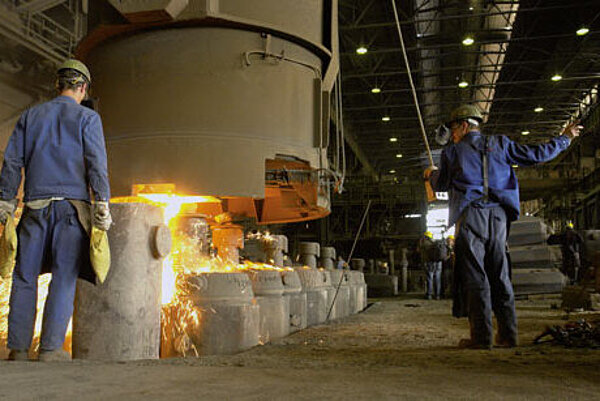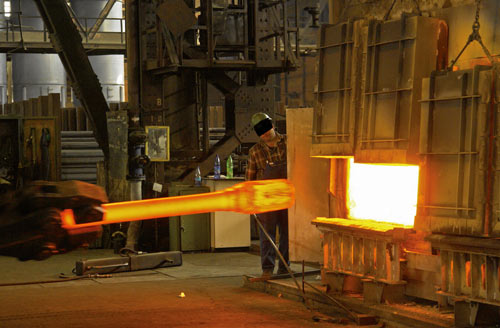Fire-resistant HFC hydraulic fluids
The analysis of fire-resistant HFC hydraulic fluids
The fluids used in hydraulic systems must fulfil a variety of tasks. They transmit power, lubricate moving parts, cool, protect against corrosion, dampen vibrations and remove contaminants. Classic hydraulic oils such as HLP, HVLP, HLPD, etc., are manufactured predominantly on the basis of mineral oils. Rapidly biodegradable hydraulic oils consist mainly of ester-based synthetic oils. Hydraulic installations exposed to an increased risk of fire nevertheless require fluids that are fire-resistant or do not continue to burn autonomously. Due to their particular composition, other test methods are employed for the analysis of HFC and HFD waste oils, as is the case for mineral oil-based products. OELCHECK can also provide suitable analysis kits.
Fire-resistant hydraulic fluids are indispensable for applications in numerous industries and are partly prescribed by law - these include the coal mining, steel and foundry industry, forging presses and metal die casting machines, control equipment of power plant turbines or aircraft flight controls. Fires can break out in the event of leakages or line breaks by mineral oil-based hydraulic oils having a spontaneous ignition temperature below 400°C making contact with highly heated system components. As a result, a hydraulic installation can constitute a high risk. In foundries, for example, systems are installed with several thousand litres of hydraulic fluid. In the event of leakage, it is highly probable that a mineral oil will ignite on contact with the red-hot steel. This would create a fiery inferno within seconds, with fatal consequences for both the people working there and the production facilities.

Fire-resistant and flame-retardant
The criteria for the fire resistance of hydraulic oils are specified in current specifications, directives and standards („7. Luxemburg Report“, ISO 6743/4, VDMA, CETOP, etc.). Fire-resistant HFC hydraulic fluid should not catch fire, e.g. even at temperatures above 600°C. However, „fire resistant“ does not mean that such hydraulic fluids cannot burn at all.
In simple terms „fire resistance“ means greater fire safety as well as offering more time to bring people to safety in the event of an accident and initiate fire-fighting measures.
Classification of fire-resistant hydraulic fluids
In general, fire-resistant hydraulic fluids can be divided into two categories: hydrous and anhydrous fluids. Classification is shown in the table below.
Hydrous fire-resistant fluids HFA – these fluids contain an extremely high water content of over 80%. HFA-E are mineral or synthetic oil based oil-in-water emulsions. HFA-S belong to synthetic solutions that are generally polyglycol based. These usually contain more water than the emulsions.
Classification of fire-resistant hydraulic fluids | ||||
|---|---|---|---|---|
Gruppe | Wasser-content | Description | Typical applications | |
HFA | HFA-E | about | Oil-in-water emulsion | Mining, pressure water installations |
| HFA-S | about | Synthetic solution | Mining, pressure water installations |
HFB |
| about | Water-in-oil emulsion | Not approved for use in Germany due to high mineral oil content |
HFC | HFC | about 50 % | Polymer solution (water/glycol) | Mining, steel industry, foundry |
| HFC-E | about 20 % | Polymer solution (water/glycol) | Mining, steel industry |
HFD | HFD-R | 0 % | Phosphoric acid ester | Control liquid in steam turbines, |
| HFD-S | 0 % | Anhydrous chlorinated | |
| hydrocarbons | ||||
| HFD-T | 0 % | Mixture of HFD R and HFD S | |
| HFD-U | 0 % | Carboxylic acid ester | at very high pressures or as environmentally-friendly fire-resistant fluids, e.g. in tunnel drilling machines |
HFA fluids are often used at temperatures between +5°C and +55°C and at relatively moderate pressures for underground mining. As they are very thin-bodied like water, leakage losses are a frequent occurrence. Their useful life may be impaired by bacteria and fungal infestation.
HFB – this category also includes water-in-oil emulsions. These contain about 40% water; the remainder is usually mineral oil. These are also fire-resistant, but not approved for use in Germany due to their poor fire properties.
HFC – these are the most common hydrous, fire-resistant hydraulic fluids as they have the best fire resistance and hydraulic properties. Fluids of this type are water-glycol based, aqueous polymer solutions and have a water content of about 50% or about 20% as HFC-E.
HFC fluids are prescribed for underground mining. They are also used wherever hydraulic fluid escaping under high pressure can ignite on contact with hot materials. At temperatures above 600°C, these fluids should not ignite or continue to burn. These fluids can be used at ambient temperatures of -20°C to +65°C and up to working pressures of 250 bar. When using these fluids, a stable ratio between water and glycol must be ensured as changes in viscosity may result due to the evaporation of water at high temperatures.
Anhydrous fire-resistant fluids HFD – these fluids have the best hydraulic properties of all fire-resistant hydraulic fluids. They are preferably used when working with a naked flame or red-hot materials. These fluids are also used as a control fluid in steam turbines or aircraft engines. HFD-R is phosphoric acid ester based, HFD-S is anhydrous chlorinated hydrocarbon based. Carboxylic acid ester is used for the production of HFD-U, which is particularly suitable for very high pressures or as an environmentally-friendly fire-resistant fluid, e.g. in tunnel drilling machines. The operating temperature range of HFD fluids is between -20°C and +150°C.
An installation to be changed from an HFC fluid to an HFD fluid must be thoroughly flushed beforehand. Vice versa, HFD residues in the system must be thoroughly removed and bound with special chemicals if necessary.
Special analyses for fire-resistant hydraulic fluids
Oil analyses have been firmly established in the field of hydraulics for monitoring oil condition and for pro-active maintenance. The aim is to increase operational reliability and availability and reduce costs at the same time by:
- safely adjusting the oil changing intervals to suit the prevailing conditions by monitoring the condition of the oil;
- monitoring the oil purity as the most frequent cause of failure;
- ensuring that operators effectively optimise oil maintenance measures;
- recognising irregularities in good time to avoid unplanned failures.
Due to their special composition and the underlying conditions resulting from their use, fire-resistant fluids require the use of additional special investigation methods. Similar to rapidly biodegradable hydraulic fluids, anhydrous HFD fluids can be checked with „Biosets“ using the OELCHECK analysis kit 3. Owing to their high water content, certain aspects must be taken into account for hydrous HFC fluids. OELCHECK offers an investigation programme that has been specially adapted for hydrous HFC fluids.
For the routine testing of HFC fluids in medium-sized installations, OELCHECK offers the analysis kit 3. The following parameters are monitored:
- Element analysis Metallic particles, dust, corrosion, additives, tramp oils, salts, e.g. from the water.
- PQ-Index Magnetic metal particles or contaminants.
- Kinematic viscosity at 40°C Lubricity and fluidity, oil aging, water loss.
- Water content in % Monitoring of the application concentration, evaporation compensation.
- pH/reserve alkalinity Monitoring of chemical additives: residually active additive reserve for neutralisation and corrosion protection.
- Visual check Coarse contaminants, turbidity, discolouration, tramp oil.
For hydraulic installations with capacities of several hundred litres or installations with increased availability or additionally required longevity of components or oil filling, OELCHECK recommends the analysis kit 5, which also tests the following parameters:
- Solid contaminants Contamination control, filtration and indication of the solid contaminant content in per cent by weight.
- Density Control parameters for application concentration and tramp oil content
- Purity class Particle counting (fine and very fine particles), quality of filtration

ÖlChecker Winter 2011, page 5




